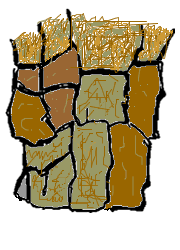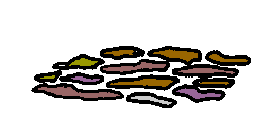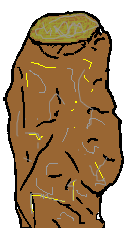There are a number of definitions and classifications for soil structure. In general terms soil structure describes how the soil particles and aggregates are arranged.
A soil that has a good soil structure will contain adequate pore spaces for root growth and will have aggregates that are of a size and shape that promote a relatively persistent state of the pores and aggregates in the soil.
A poorly structured soil is one that has minimal pore spaces, with soil particles and small aggregates filling the spaces between larger aggregates. A compacted sportspitch is a good example of a structureless soil.
Within a soil profile there are several types of soil ped (individual aggregates) that are recognised. These are as follows:
| Soil ped name | Sub-division | Description | Diagrammatic representation of ped |
| Blocky | Angular | Vertical and Horizontal cracking are fairly evenly balanced. The edges of the aggregates are relatively sharp. When the soil is wet, the aggregates swell and fit together like a jigsaw. |
 |
| Sub-angular | Vertical and Horizontal cracking are fairly evenly balanced. The edges of the aggregates are more rounded. When the soil is wet, the aggregates swell and fit together like a jigsaw. |
 |
|
| Laminar (or Platy) | Not applicable | Cracking of the aggregates is most significant along the Horizontal plane. |  |
| Prism - like | Columnar | Cracking of the aggregates is significantly along the Vertical. The tops of the aggregates have a generally rounded feature. |
 |
| Prismatic | Cracking of the aggregates is significantly along the Vertical. The tops of the aggregates are more angular and sharp edged. |
 |
|
| Spheriodal | Crumb | These aggregates are more rounded than Blocky aggregates. Noticeable pore spaces remain between the aggregates when the soil swells. There is good porosity within the soil profile. |
 s s |
| Granular | These peds are similar to the crumb ped, however, they have fine particles in between the aggregates, resulting in low porosity. |  |
The soil peds are typically made up of smaller aggregates (also called structural units). Four main structural units are recognised.
Structural Units
| Unit name | Size | Description |
| Domain | 5 micron (0.005mm) | This is an aggregation of clay particles. |
| Granule | < 500 micron (0.5mm) | Clay domains, silt and fine sand form these small units. |
| Crumb | 0.5 - 10mm
It is convenient to sub-divide this unit into aggregates of (a) 0.5 - 2mm (b) 2 - 5mm (c) 5 - 10mm |
This is a group of granules.
Having crumb sub-divisions allows a soil to be analysed in more detail following any wet sieving. Seed bed preparation will have crumbs for the tilth. |
| Clod | > 10mm | These are relatively large soil aggregates.
Small clods may be suitable for soil areas that require turfing, but larger clods will need to be broken down into crumbs. |
